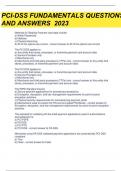Samenvatting
Summary PSY4761. Personality disorders. Taak 2: Avoidant and Dependent personality disorder
PSY4761: Personality disorders. Uitgebreide uitwerking van de leerdoelen behorende tot taak 2: Avoidant and dependent personality disorder. Inclusief bronvermeldingen en in oranje de aantekeningen uit de tutorial. Voor alle taken, zie de bundel.
[Meer zien]













